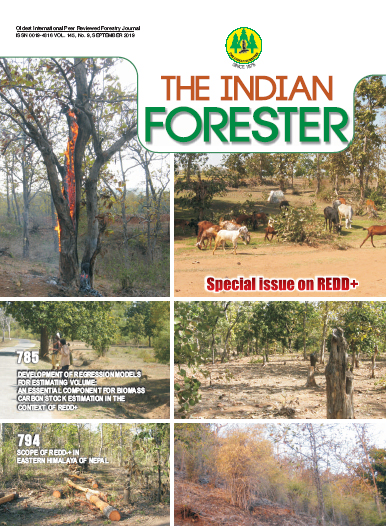Baseline Forest Carbon Stocks Assessment for REDD+ Pilot Project in Uttarakhand Himalaya
DOI:
https://doi.org/10.36808/if/2019/v145i9/148724Keywords:
Change, Reference Level/Baseline, National REDD Strategy, MRV, Carbon Credit.Abstract
Globally land use and land-use change activities accounted for about 9-11 % of total annual anthropogenic greenhouse gas emissions. REDD+ introduced under UNFCCC as major global intervention to meet GHG reduction objectives through addressing drivers of deforestation and forest degradation, promoting conservation of forest carbon stocks, sustainable management of forests and enhancement of forest carbon stocks. With agreement on Warsaw Framework for REDD+, it is now well matured under UNFCCC which has also been endorsed by the Paris Climate Agreement. Parties, entities willing to participate in REDD+ programmes need to develop a reference level or a baseline of forest carbon stocks in the project area. The present study aims to assess baseline carbon stocks at sub-national level in a small sub-watershed Uttarakhand covering 43,000 ha to assess the REDD+ project carbon benefits as a result of various forest management and conservation activities aimed at conservation of forest carbon stocks, sustainable management of forests and/or enhancement of forest carbon stocks. The baseline carbon stocks in the Sub-watershed was estimated 166.76MgC ha-1 with a total of 7.50 million tones.References
Agarwal, A., Das S. and Paul V. (2009). Is India ready to implement REDD-plus? A preliminary Assessment. The Energy and Resource Institute, New Delhi.
Devi, L.S. and Yadava P.S. (2015). Carbon stock and rate of carbon sequestration in Dipterocarpus forests of Manipur, Northeast India. J. Forestry Research, 26(2):315-322.
FSI (nd) Carbon Stock in India's Forests, Forest Survey of India, Ministry of Environment and Forest Dehra Dun.
Haripriya G.S. (2000). Estimates of biomass in Indian forests. Biomass and Bioenergy, 19(4):245-258.
IPCC, (2006). IPCC Guidelines for National Greenhouse Gas Inventories. Prepared by the National Greenhouse Gas Inventories Programme, Institute for Global Environmental Strategies (IGES), Japan.
IPCC, (2003). Good Practice Guidance for Land Use, Land Use Change and Forestry, Institute for Global Environmental Strategies (IGES), Japan.
IPCC, (2014). Climate Change 2014: Mitigation of Climate Change. Contribution of Working Group III to the Fifth Assessment Report of the Intergovernmental Panel on Climate Change, Cambridge, Cambridge University Press, United Kingdom and New York, USA.
Jana, B.K., Biswas S., Majumder M., Roy P.K. and Mazumdar A. (2009). Carbon sequestration rate and aboveground biomass carbon potential of four young species. J. Ecology and Natural Environment, 1(2):015-024.
Kaul M., Mohren G.M.J. and Dadhwal V.K. (2010). Carbon storage and sequestration potential of selected tree species in India. Mitigation and Adaptation Strategies for Global Change, 15(5):489-510.
Khum B.T.M. and Shrestha B.B. (2015). Carbon stock in community managed hill sal (Shorea robusta) forests of Central Nepal. J. Sustainable Forestry, 34(5):483-501.
Manhas R.K., Negi J.D.S, Rajesh K. and Chauhan P.S. (2006). Temporal Assessment of growing stock, biomass and carbon stock of Indian Forests. Climate Change, 74:191-221.
MoEF (2014). National Working Plan Code-2014 (for Sustainable Management of Forests and Biodiversity), Forest Research Institute, Ministry of Environment and Forests, Government of India.
MoEFCC (2018). National REDD+ Strategy India, Ministry of Environment, Forest and Climate Change, Government of India.
Pandey S.S., Maraseni T.N. and Cockfield G. (2014). Carbon stock dynamics in different vegetation dominated community forests under REDD+: A case from Nepal. Forest Ecology and Management, 327:40-47.
Pant P., Sharma P., Jain S. and Gregoire T.G. (2010). Analysis of REDD for India: Opportunities and Challenges. VDM Verlag Dr. Mueller, Germany.
Pant H. and Tewari A. (2013). Carbon Sequestration Potential of Chir Pine (Pinus roxburghii Sarg) Forest on Two Contrasting Aspects in Kumaun Central Himalaya between 1650-1860 m Elevation. Applied Ecology and Environmental Science, 1(6):110-112.
Rajput S.S., Shukla N.K., Gupta V.K. and Jain J.D.(1996). Timber mechanics: strength, classification and grading of timber. Indian Council of Forestry Research and Education, Dehradun.
Rawat V.R.S. and Kishwan J. (2008). Forest conservation- based, climate change-mitigation approach for India. Inter. Forestry Review, 10(2):269-280.
Sheikh M.A., Kumar S. and Kumar M. (2012). Above and below ground organic carbon stocks in a sub-tropical Pinus roxburghii. Sargent forest of the Garhwal Himalayas. Forestry Studies in China, 14(3): 205-209.
Singh T.P., Rawat V.R.S. and Rawat R.S. (2015). Implementing REDD+ as a Climate Mitigation Option in India. Indian Forester, 141(1): 9-17.
TERI (2012). Proceedings of National level Consultation on International REDD Plus Architecture and its relevance for India New Delhi. 14June, 2012. India Habitat Centre, New Delhi.
Walkley A. and Black I.A. (1934). An examination of Degtjareff method for determining soil organic matter and a proposed modification of the chromic acid titration method. Soil Science, 37: 29-38.
Downloads
Downloads
Published
How to Cite
Issue
Section
License
Unless otherwise stated, copyright or similar rights in all materials presented on the site, including graphical images, are owned by Indian Forester.





